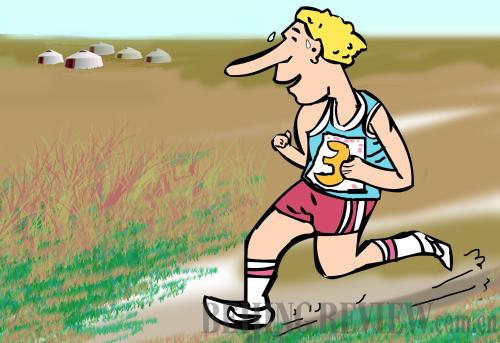|
 |
|
(LI SHIGONG) |
For some, simply running 21 km, or a full marathon at 42 km, isn't enough of an achievement. I mean, you can run a marathon in almost every major city in the world and many of them are centerpiece events watched by a global audience.
But since coming to China, and choosing to return to running as my preferred option for keeping fit, I have discovered a new dimension to running: extreme marathons boasting the kind of experiences only possible in China.
For example, in May, I joined busloads of people as we headed to the small town of Huangyaguan, nestled in a valley and in the shadow of a restored section of the Great Wall in Beijing. Some of the runners had traveled to China specifically for this event.
Unlike a conventional run, the first 5 km took us up a steady incline before arriving at an entrance to the Great Wall. From there it was a very steep climb up and over, spending the next 3 km gently jogging, though in most cases we did little more than walking or even waiting patiently as queues formed to try to get through the narrow passes.
Over the course of the marathon, the gradients and surface under foot changed dramatically—the former from very steep inclines to pace-building descents, while the latter went from renovated stonework to treacherous gravel and soil. But throughout, as regular pauses forced us to stop and catch our breath, there was a much better chance than in a normal race to bond—or at least share a weary but happy smile—with fellow runners.
Once off the wall, the run led us back into the town before taking us out into a neighboring village where almost every resident was out to cheer, smile and offer support to the hordes of runners. Little children would wave and offer hands for high-fives and older locals would offer a kindly encouragement to anyone who seemed to be lagging behind.
For those running the half marathon (myself included), the race ended once back into Huangyaguan. But for the dedicated full marathon runners, now was a test of true mental strength as they had to watch their half marathon counterparts munch on sandwiches while they began another ascent up the incredibly steep wall. It was a truly grueling but worthwhile experience.
And so, having been bitten by the running bug, I needed to find another race to fill the void between May and the Beijing run in October. I found that race in Inner Mongolia.
High in the northeast of the autonomous region in north China, the annual run attracts far less runners than the Great Wall event, but it's no less rewarding and certainly no less exhausting. After a 1-hour flight to Xilinhot, the journey alone was extreme as we bounced unnervingly for 2 hours over bumpy, dusty dirt tracks. Next to us heavy machinery toiled making what would one day be a much smoother road into town.
The race started in the small town of Xi Ujimqin Banner before quickly heading into the nearby grasslands. Naively, given the description, I had been expecting to run on grass, but the well-worn path was actually mostly sand—soft, energy-sapping sand. Add to that the hot July temperature and the race's later-than-usual start of 9 a.m. and it was evident this race was going to be a different kind of extreme than the Great Wall run.
Within a few kilometers of the starting line, the sparse number of runners were already starting to spread out and at several points on the course I found myself totally alone with nothing in sight except for the rich green of high grasses, the soft, rolling mounds of earth and the deep blue of the virtually cloudless sky—the kind of sky one hardly ever sees in the Beijing.
But as hard as it was to totally take in the surroundings with my lungs burning and legs aching, stopping for just a minute or two offered its own reward. The gentle wind would often ripple through the grass, causing it to look almost like a calm, green sea. The sound of nothing but the wind added to the general euphoria of running.
After a draining 19 km, a disappointing lack of yaks and a quick stop to take my shoes off to relieve a cramp, I found myself heading back into Xi Ujimqin Banner, where the small number of runners meant nearly everyone got their own personal police escort. Smiling from their motorcycles, the police offered that last push of encouragement as the finish line slowly appeared and a well-deserved sit on the ground and massive chunk of watermelon waited.
With two extreme half marathons under my belt this year, it's time to look ahead to the race in the capital and running through familiar roads and past familiar landmarks.
I can't wait.
The author is from Wales and lives in Beijing | 